A Triple Band Substrate Integrated Waveguide with Dielectric Resonator Antenna for 4G and 5G Applications
Abstract
:1. Introduction
2. Antenna Geometry and Design Consideration
2.1. Evolution of the Design
2.2. Electric Field Distribution
2.3. Parametric Studies
3. Results and Discussion
4. Conclusions
Author Contributions
Funding
Data Availability Statement
Conflicts of Interest
References
- Aminu-Baba, M.; Rahim, M.K.A.; Zubir, F.; Iliyasu, A.Y.; Jahun, K.I.; Yusoff, M.F.M.; Gajibo, M.M.; Pramudita, A.A.; Lin, I.K.C. A compact triband miniaturized MIMO antenna for WLAN applications. AEU—Int. J. Electron. Commun. 2021, 136, 153767. [Google Scholar] [CrossRef]
- Lin, I.K.C.; Jamaluddin, M.H.; Awang, A.; Selvaraju, R.; Dahri, M.H.; Yen, L.C.; Rahim, H.A. A triple band hybrid MIMO rectangular dielectric resonator antenna for LTE applications. IEEE Access 2019, 7, 122900–122913. [Google Scholar]
- Wu, K.; Cheng, Y.J.; Djerafi, T.; Hong, W. Substrate-integrated millimeter-wave and terahertz antenna technology. Proc. IEEE 2012, 100, 2219–2232. [Google Scholar]
- Zou, Y.Y.; Kong, Y.D. A Wideband Substrate Integrated Waveguide Slot Antenna with Quad Modes. In Proceedings of the IEEE International Conference on Computational Electromagnetics (ICCEM), Shanghai, China, 20–22 March 2019; pp. 1–3. [Google Scholar]
- Ashraf, N.; Haraz, O.; Ashraf, M.A.; Alshebeili, S. 28/38-GHz dual-band millimeter wave SIW array antenna with EBG structures for 5G applications. In Proceedings of the International Conference on Information and Communication Technology Research (ICTRC), Abu Dhabi, United Arab Emirates, 17–19 May 2015; pp. 5–8. [Google Scholar]
- Cheng, T.; Jiang, W.; Gong, S.; Yu, Y. Broadband SIW cavity-backed modified dumbbell-shaped slot antenna. IEEE Antennas Wirel. Propag. Lett. 2019, 18, 936–940. [Google Scholar] [CrossRef]
- Srivastava, A.; Chaudhary, R.K.; Biswas, A.; Akhtar, M.J. Dual-band L-shaped SIW Slot antenna. In Proceedings of the International Conference on Microwave and Photonics (ICMAP), Dhanbad, India, 13–15 December 2013; pp. 6–8. [Google Scholar]
- Petosa, A. Dielectric Resonator Antenna Handbook; Artech House: Norwood, MA, USA, 2007. [Google Scholar]
- Thilagam, B.K.; Kartha, M.M.; Jayakumar, M. Performance Analysis of Cylindrical Dielectric Resonator Antenna with various slot configurations on Substrate Integrated Waveguide. Int. J. Control Theory Appl. 2016, 9, 7581–7588. [Google Scholar]
- Girjashankar, P.R.; Upadhyaya, T. Substrate integrated waveguide fed dual band quad-elements rectangular dielectric resonator MIMO antenna for millimeter wave 5G wireless communication systems. AEU—Int. J. Electron. Commun. 2021, 137, 153821. [Google Scholar] [CrossRef]
- Banerjee, S.; Parui, S.K. Bandwidth improvement of substrate integrated waveguide cavity-backed slot antenna with dielectric resonators. Microsyst. Technol. 2020, 26, 1359–1368. [Google Scholar] [CrossRef]
- Ashraf, N.; Vettikalladi, H.; Alkanhal, M.A.S. A DR loaded substrate integrated waveguide antenna for 60 GHz high speed wireless communication systems. Int. J. Antennas Propag. 2014, 2014, 146301. [Google Scholar] [CrossRef] [Green Version]
- Chemweno, E.K.; Kumar, P.; Afullo, T.J.O. Design of high-gain wideband substrate integrated waveguide dielectric resonator antenna for D-band applications. Optik 2023, 272, 170261. [Google Scholar] [CrossRef]
- Iqbal, A.; Tiang, J.J.; Wong, S.K.; Alibakhshikenari, M.; Falcone, F.; Limiti, E. Miniaturization Trends in Substrate Integrated Waveguide (SIW) Filters: A Review. IEEE Access 2020, 8, 223287–223305. [Google Scholar] [CrossRef]
- Bilawal, F.; Babaeian, F.; Trinh, K.T.; Karmakar, N.C. The Art of Substrate-Integrated-Waveguide Power Dividers. IEEE Access 2023, 11, 9311–9325. [Google Scholar] [CrossRef]
- Kumar, P.; Dwari, S.; Singh, S.; Agrawal, N.K. Design Investigation of a Laminated Waveguide Fed Multi-Band DRA for Military Applications. Frequenz 2018, 72, 7–14. [Google Scholar] [CrossRef]
- Kumar, H.; Jadhav, R.; Ranade, S. A Review on Substrate Integrated Waveguide and its Microstrip Interconnect. J. Electron. Commun. Eng. 2012, 3, 36–40. [Google Scholar] [CrossRef]
- Lemey, S.; Declercq, F.; Rogier, H. Dual-band substrate integrated waveguide textile antenna with integrated solar harvester. IEEE Antennas Wirel. Propag. Lett. 2014, 13, 269–272. [Google Scholar] [CrossRef] [Green Version]
- Kim, S.; Tentzeris, M.M.; Traille, A.; Aubert, H.; Georgiadis, A. A dual-band retrodirective reflector array on paper utilizing Substrate Integrated Waveguide (SIW) and inkjet printing Technologies for Chipless RFID Tag and Sensor Applications. In Proceedings of the IEEE Antennas and Propagation Society International Symposium (APSURSI), Orlando, FL, USA, 7–13 July 2013; pp. 2301–2302. [Google Scholar]
- Kumar, A.; Bhaskar, S.; Singh, A.K. SIW cavity-backed U-shaped slot antenna for 5G applications. In Proceedings of the IEEE Asia-Pacific Microwave Conference (APMC), Singapore, 10–13 December 2019; pp. 1485–1487. [Google Scholar]
- Ta, S.X.; Choo, H.; Park, I. Broadband printed-dipole antenna and its arrays for 5G applications. IEEE Antennas Wirel. Propag. Lett. 2017, 16, 2183–2186. [Google Scholar] [CrossRef]
- You, W.; Wang, Z.; Nie, W.; Mu, W. A 12-Port MIMO Antenna System for 5G/WLAN Applications. Micromachines 2023, 14, 1196. [Google Scholar] [CrossRef]



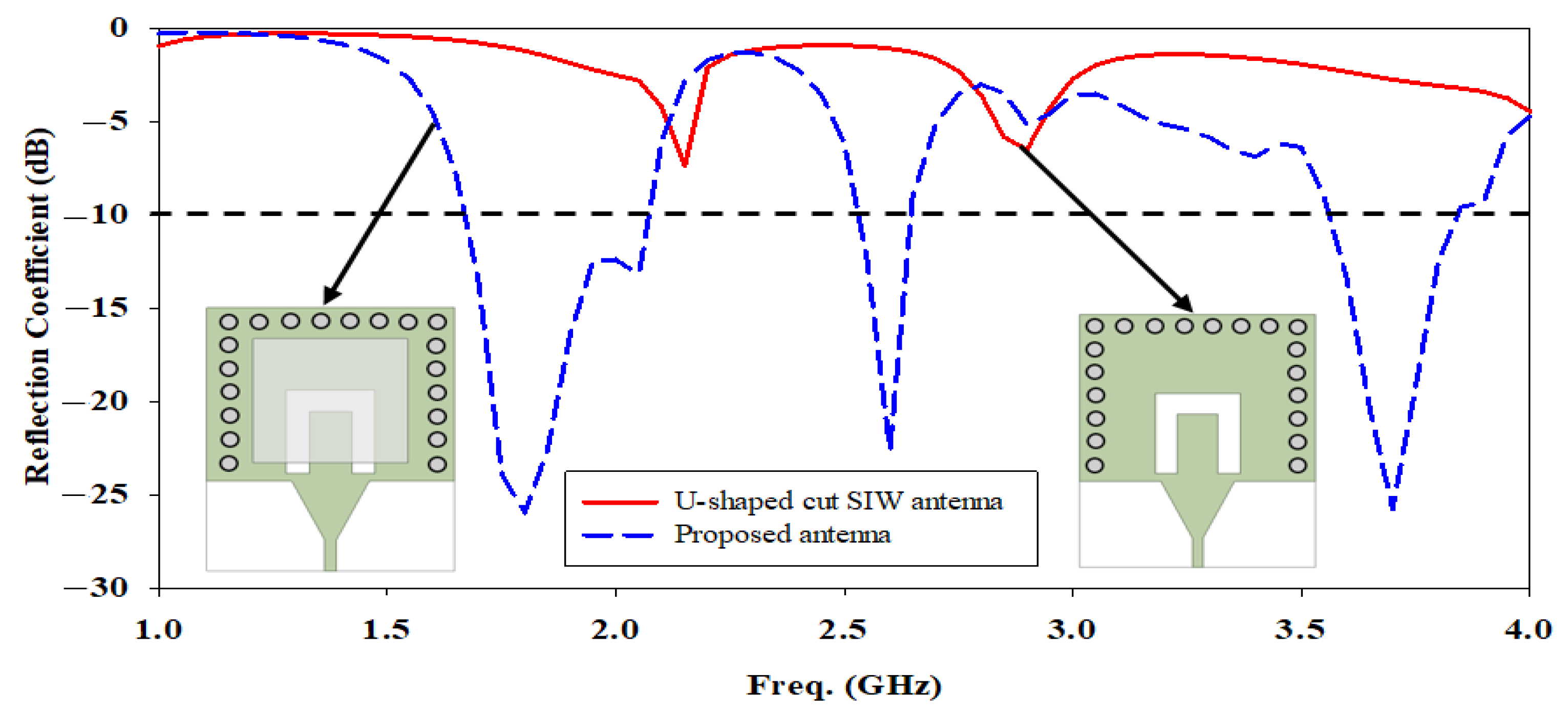
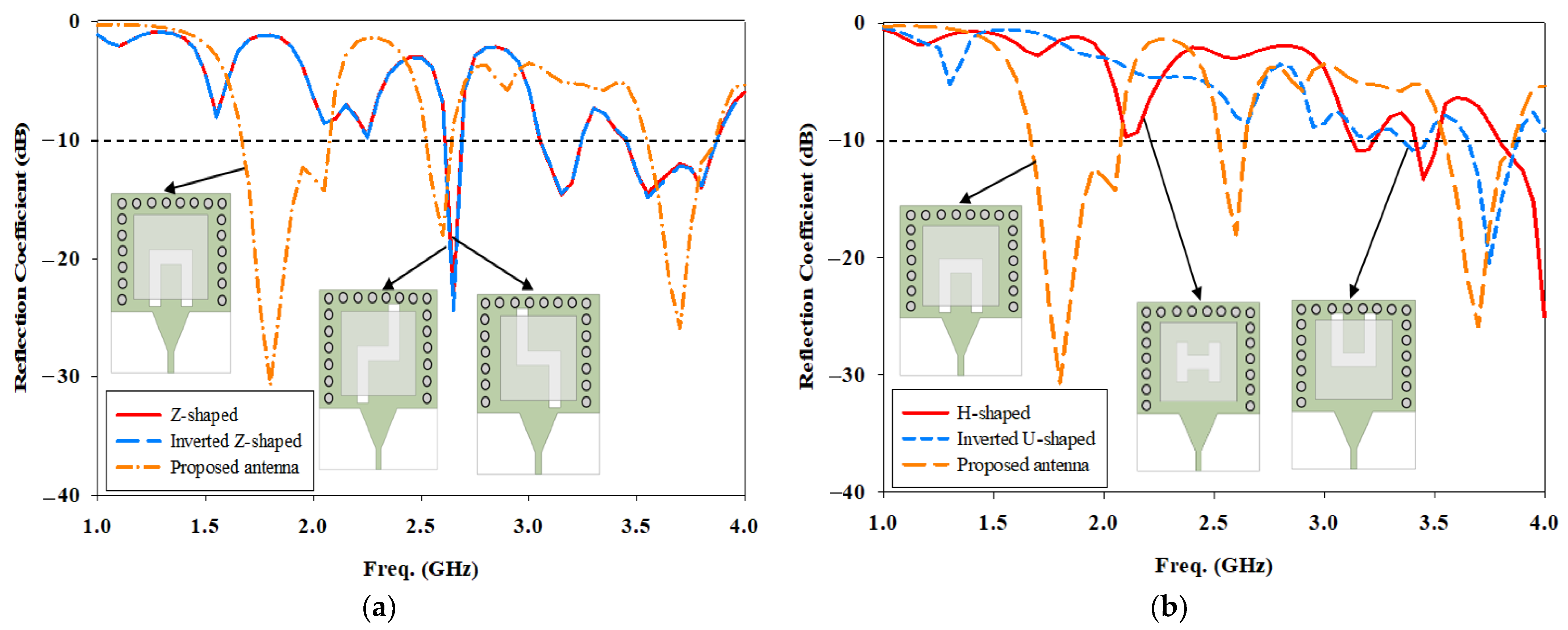
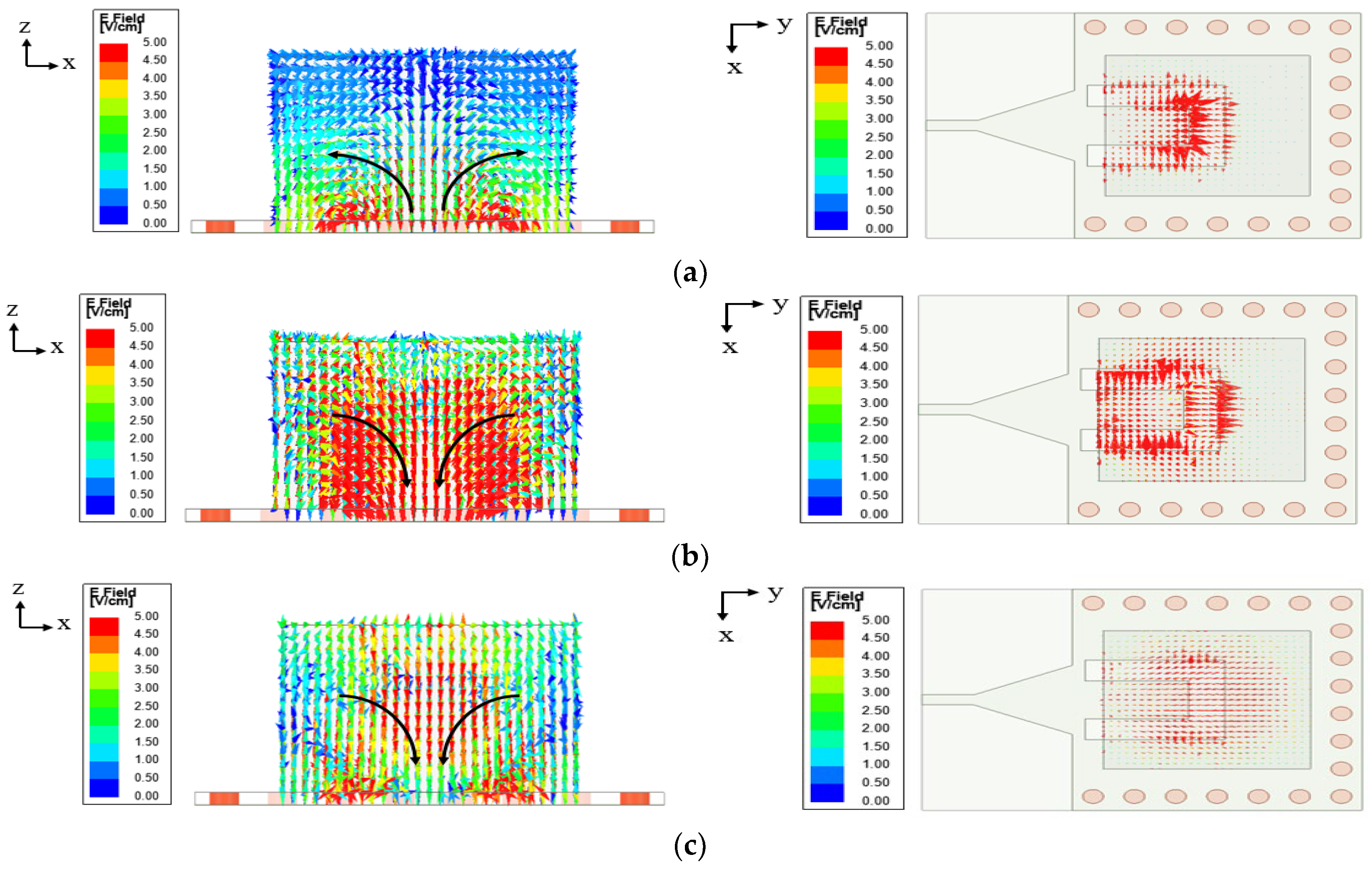

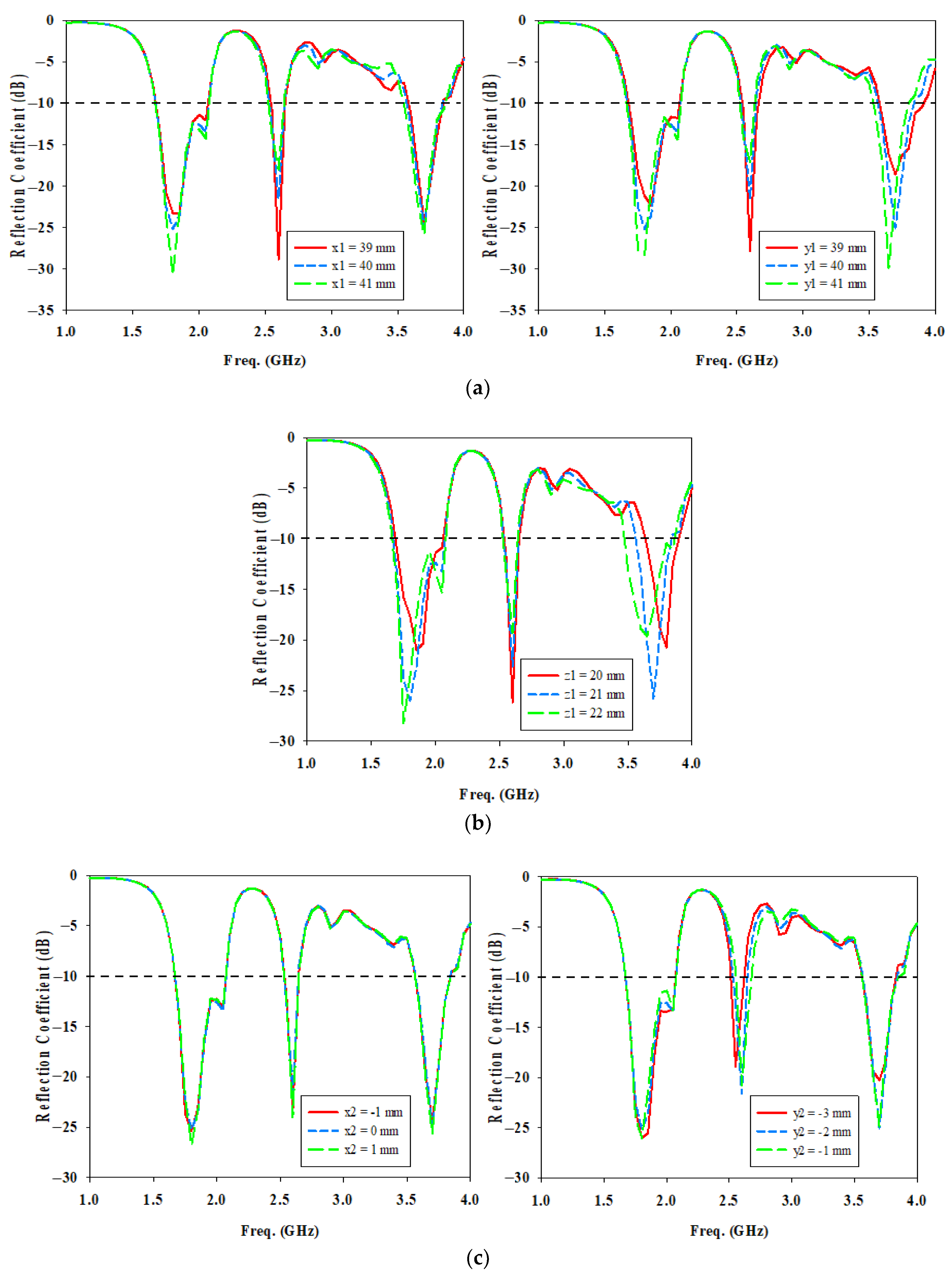
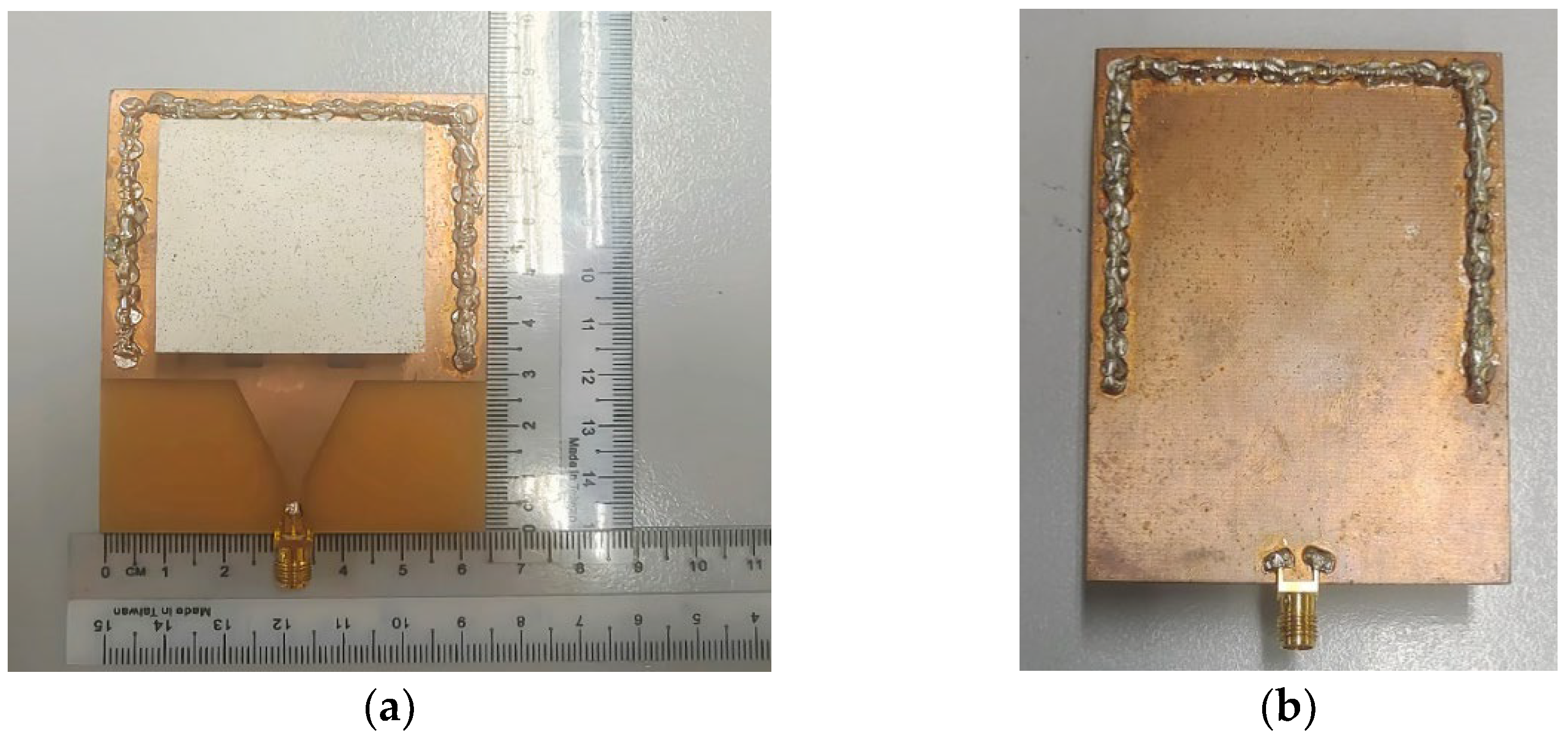


| Parameter | Value (mm) | Parameter | Value (mm) | Parameter | Value (mm) | Parameter | Value (mm) |
|---|---|---|---|---|---|---|---|
| sa | 64 | x2 | 0 | sw | 7 | a1 | 6 |
| sb | 56 | y2 | −2 | sl2 | 20 | a2 | 10 |
| sc | 85 | lf | 10 | sw2 | 6 | a3 | 12 |
| sd | 1.6 | lt | 19 | sx | 0 | a4 | 2 |
| x1 | 40 | wf | 2.95 | sy | −2 | Weq | 52 |
| y1 | 40 | wt | 20 | d | 4 | Wsiw | 56 |
| z1 | 21 | sl | 23 | p | 8 |
| Antenna Parameters | 1.8 GHz | 2.6 GHz | 3.7 GHz | |
|---|---|---|---|---|
| Covered Bandwidth (%) | Sim. | 21.51 | 5.78 | 7.57 |
| Mea. | 19.50 | 6.58 | 8.21 | |
| Gain (dBi) | Sim. | 5.0 | 4.5 | 6.9 |
| Mea. | 4.9 | 4.4 | 6.7 | |
| Total Antenna Efficiency (%) | Sim. | 83.9 | 74.4 | 76.9 |
| Mea. | 81.0 | 72.7 | 73.5 |
| Year [Ref.] | Shapes of Slot/Cut | DRA | Frequency (GHz) | Bandwidth (%) | Gain (dBi) | Total Antenna Efficiency (%) |
|---|---|---|---|---|---|---|
| 2014 [18] | A horizontal slot | No | 2.60 | 16.05 | 5.1 | 92.0 |
| 2013 [19] | Two vertical cuts | No | 3.60 | 12.61 | Not stated | Not stated |
| 2019 [6] | A dumbbell-shaped slot | No | 22.00 | 26.06 | 8.0 | Not stated |
| 2019 [20] | A U-shaped slot | No | 28.00 | 13.79 | 7.2 | Not stated |
| 2013 [7] | L-shaped slot | No | 10.93 12.69 | 1.56 1.42 | Not stated | Not stated |
| 2015 [5] | Two vertical cuts | No | 28.00 38.00 | 1.61 5.82 | 5.2 5.9 | Not stated |
| 2020 [11] | A horizontal cut | 1 RDRA | 5.90 | 12.37 | 4.7 | Not stated |
| 2016 [9] | A plus-shaped cut | 1 CDRA | 6.56 | 8.54 | 3.7 | Not stated |
| 2014 [12] | A H-shaped slot | 2 RDRAs | 60.00 | 10.03 | 5.5 | 81.0 |
| 2021 [10] | A horizontal cut | 1 RDRA | 28.00 38.00 | 13.62 9.94 | Not stated | Not stated |
| Current proposed design | A U-shaped cut | 1 RDRA | 1.80 2.60 3.70 | 19.50 6.58 8.21 | 4.9 4.4 6.7 | 81.0 72.7 73.5 |
Disclaimer/Publisher’s Note: The statements, opinions and data contained in all publications are solely those of the individual author(s) and contributor(s) and not of MDPI and/or the editor(s). MDPI and/or the editor(s) disclaim responsibility for any injury to people or property resulting from any ideas, methods, instructions or products referred to in the content. |
© 2023 by the authors. Licensee MDPI, Basel, Switzerland. This article is an open access article distributed under the terms and conditions of the Creative Commons Attribution (CC BY) license (https://creativecommons.org/licenses/by/4.0/).
Share and Cite
Cheh Lin, I.K.; Jamaluddin, M.H.; Gaya, A. A Triple Band Substrate Integrated Waveguide with Dielectric Resonator Antenna for 4G and 5G Applications. Micromachines 2023, 14, 1284. https://doi.org/10.3390/mi14071284
Cheh Lin IK, Jamaluddin MH, Gaya A. A Triple Band Substrate Integrated Waveguide with Dielectric Resonator Antenna for 4G and 5G Applications. Micromachines. 2023; 14(7):1284. https://doi.org/10.3390/mi14071284
Chicago/Turabian StyleCheh Lin, Irene Kong, Mohd Haizal Jamaluddin, and Abinash Gaya. 2023. "A Triple Band Substrate Integrated Waveguide with Dielectric Resonator Antenna for 4G and 5G Applications" Micromachines 14, no. 7: 1284. https://doi.org/10.3390/mi14071284
APA StyleCheh Lin, I. K., Jamaluddin, M. H., & Gaya, A. (2023). A Triple Band Substrate Integrated Waveguide with Dielectric Resonator Antenna for 4G and 5G Applications. Micromachines, 14(7), 1284. https://doi.org/10.3390/mi14071284








